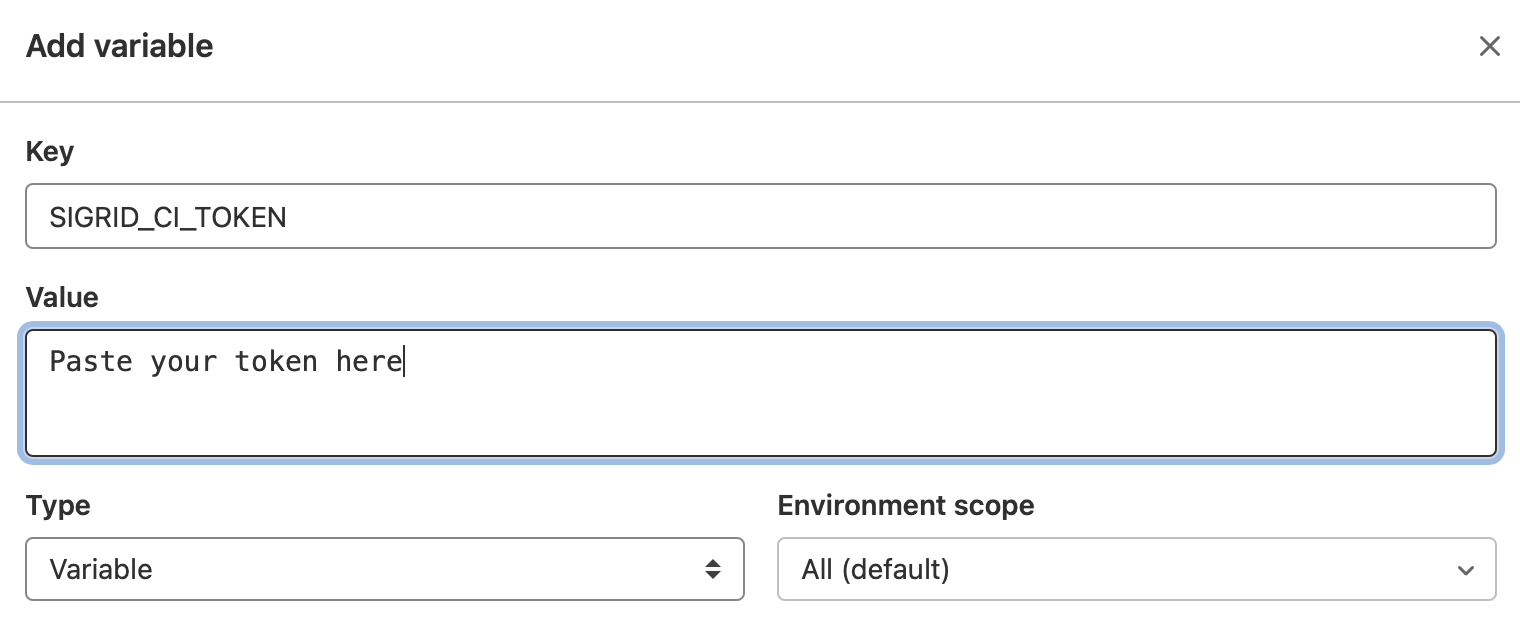Integrating Sigrid CI with Mendix QSM on a GitLab server
Please note: QSM is the brand name used by Mendix, in this manual we will use Sigrid.
This documentation covers cloud-based Sigrid. For on-premise Sigrid, refer to the section about on-premise analysis configuration.
Prerequisites
- You are not using the default Mendix teamserver, but you are using your own Git server for version control of your projects.
- You would like to trigger the Sigrid analysis from within your own pipeline in Git.
- Your runners are able to pull this public docker image, the image is used to preprocess the Mendix code before uploading it to Sigrid.
- You have a Sigrid user account.
- You have created an authentication token using Sigrid.
- You have created a Personal access (PAT) token using the Mendix user settings
On-boarding your system to Sigrid
On-boarding is done automatically when you first run Sigrid CI. As long as you have a valid token, you will receive the message system has been on-boarded to Sigrid. Subsequent runs will then be visible in both your CI environment and sigrid-says.com.
Configuration
Step 1: Configure both the Sigrid credential and the Mendix PAT to environment variables
Sigrid CI reads your credentials from 2 environment variables called SIGRID_CI_TOKEN and MENDIX_TOKEN.
To add these to your GitLab CI pipeline, follow these steps:
- Select “Settings” in your GitLab project’s menu
- Select “CI/CD” in the settings menu
- Locate the section named “Variables”
- Click the “Add variable” button
- Add an first environment variable
SIGRID_CI_TOKENand use your Sigrid authentication token as the value. - Add an second environment variable
MENDIX_TOKENand use the Mendix user settings to create a PAT with ‘mx:modelrepository:repo:read’ access only.


These instructions describe how to configure a single GitLab project, but you can follow the same steps to configure the entire GitLab group, which will make the environment variables available to all projects within that group.
Step 2: Create pipeline configuration file for Gitlab
We will create a pipeline that consists of two jobs:
- One job that will publish the main branch to sigrid-says.com after every commit to main.
- One job to provide feedback on pull requests, which can be used as input for code reviews.
In the root of your repository, create a file .gitlab-ci.yml and add the following contents:
stages:
- report
variables:
SIGRID_CI_CUSTOMER: '<example_customer_name>'
SIGRID_CI_SYSTEM: '<example_system_name>'
sigridci:
image:
name: softwareimprovementgroup/mendixpreprocessor:latest
entrypoint: [""]
stage: report
script:
- /usr/local/bin/entrypoint.sh
artifacts:
paths:
- "sigrid-ci-output/*"
reports:
junit: "sigrid-ci-output/sigridci-junit-format-report.xml"
expire_in: 1 week
when: always
rules:
- if: $CI_COMMIT_REF_NAME != $CI_DEFAULT_BRANCH
sigridpublish:
image:
name: softwareimprovementgroup/mendixpreprocessor:latest
entrypoint: [""]
variables:
SIGRID_CI_PUBLISH: 'publish'
stage: report
script:
- /usr/local/bin/entrypoint.sh
artifacts:
paths:
- "sigrid-ci-output/*"
reports:
junit: "sigrid-ci-output/sigridci-junit-format-report.xml"
expire_in: 1 week
when: always
rules:
- if: $CI_COMMIT_REF_NAME == $CI_DEFAULT_BRANCH
Note the name of the branch, which is main in the example but might be different for your repository. In general, most older projects will use master as their main branch, while more recent projects will use main.
The docker image allows a few optional environment variables to be set, that are equivalent to client script options of the full Sigrid CI script. Optional variables are:
SIGRID_CI_TARGET_QUALITY: Equivalent to--target-qualityINCLUDE: Equivalent to--includeEXCLUDE: Equivalent to--exclude
Finally, note that you need to perform this step for every project where you wish to use Sigrid CI.
The output consists of the following:
- A list of refactoring candidates that were introduced in your merge request. This allows you to understand what quality issues you caused, which in turn allows you to fix them quickly. Note that quality is obviously important, but you are not expected to always fix every single issue. As long as you meet the target, it’s fine.
- An overview of all ratings, compared against the system as a whole. This allows you to check if your changes improved the system, or accidentally made things worse.
- The final conclusion on whether your changes and merge request meet the quality target.
Contact and support
Feel free to contact SIG’s support department for any questions or issues you may have after reading this document, or when using Sigrid or Sigrid CI. Users in Europe can also contact us by phone at +31 20 314 0953.

